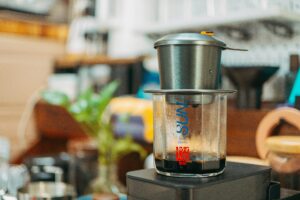Ah, the intoxicating aroma of freshly roasted coffee beans. It’s a promise of a delicious pick-me-up, a sensory experience that sets the stage for a perfect cup. But that vibrant flavor and invigorating aroma can fade all too quickly. Fear not, fellow coffee connoisseurs! We’re here to unveil the secrets of keeping your coffee beans fresh for months, ensuring every cup bursts with flavor.
Table of contents
The Freshness Foes: Unveiling the Enemies of Flavor

Imagine your coffee beans as delicate dancers on a stage. Their performance (flavor) is threatened by four main foes:
- Air: Oxygen is the villain in this story. It breaks down the precious oils in coffee beans, leading to a stale and flat taste. Think of a sliced apple – exposed to air, it browns and loses its crispness.
- Light: Just like sunlight fades a beautiful painting, light can deteriorate the delicate flavor compounds in coffee beans. Imagine hanging a prized Monet in direct sunlight – it wouldn’t stay vibrant for long.
- Heat: Excessive heat accelerates the breakdown of those flavor oils. Picture storing chocolate chips in a hot car – they’ll melt and lose their delicious flavor.
- Moisture: Moisture acts like a party crasher, promoting the growth of mold and affecting the overall quality of your beans. Think of leaving a box of crackers in a humid environment – they’ll get soggy and lose their satisfying crunch.
The Freshness Fortress: Building the Perfect Storage Environment
By understanding these enemies, we can create a fortress of freshness for our coffee beans. Here are some key strategies:
- Embrace the Opaque: Opt for airtight containers made from opaque materials like ceramic, stainless steel, or even a dark-colored glass canister. These materials block light, preventing its detrimental effects.
- The Power of the Pinch: Ensure your container has a tight-fitting lid that creates a near-airtight seal. Imagine a high-security vault – you want minimal air exchange to keep your valuables (those precious beans) safe.
- Cool and Collected: Store your coffee beans in a cool, dark, and dry location. A pantry away from the heat source (oven) is ideal. Think of storing wine in a cellar – cool, dark, and undisturbed.
- The One-Cup Conundrum: If you’re a solo coffee drinker, resist the urge to buy giant bags of beans. Once opened, those beans become more susceptible to the elements. Consider buying smaller quantities or portioning out large bags into smaller, airtight containers for daily use.
San Francisco Bay Whole Bean Coffee

- 100% Arabica Coffee
- Unique Custom Blends
- Available in Single Serve Pods
- Affordable Price
- Whole Bean
Freshness Hacks: Beyond the Basics
We’ve covered the essential storage methods, but here are some additional tips to extend the life of your coffee beans:
- The Freezer Factor: While some debate its effectiveness, freezing coffee beans can be a viable option for long-term storage. However, ensure they’re in an airtight container to prevent freezer burn. Remember to thaw them completely before grinding and brewing to avoid clumping.
- The Vacuum Seal Advantage: Invest in a vacuum sealer and vacuum seal your coffee beans in portions. This removes most of the air, creating an optimal environment for extended freshness. Imagine storing food in a vacuum-sealed bag – it significantly extends shelf life.
Freshness First: The Importance of Buying Practices
Freshness starts before you even get home from the store. Here’s what to keep in mind when buying coffee beans:
- The Roast Date: Look for the roast date on the bag! Coffee beans start losing their peak flavor within a few weeks after roasting. Aim for beans roasted within the past 2-4 weeks for optimal taste.
- Whole Bean Power: Whole beans retain their freshness longer than pre-ground coffee. The grinding process exposes more surface area to air, accelerating the deterioration of flavor. Think of an apple – once you cut it, it browns faster than a whole apple.
The Freshness Test: Identifying Stale Beans
Even with the best storage methods, coffee beans eventually lose their vibrancy. Here’s how to identify stale beans:
- The Aroma Audit: Fresh coffee beans boast a rich and complex aroma. If the smell is dull or nonexistent, your beans might be past their prime.
- The Grind Grind: Grind a small amount of your beans. If the ground coffee looks dull and lacks a pronounced aroma, it’s time for a fresh batch.
- The Taste Test: The ultimate test is the taste itself. If your coffee is flat, bitter, or lacks its characteristic flavor profile, it’s time to say goodbye to those beans.
Freshness is the Foundation: A Commitment to Flavor
By following these tips and tricks, you can transform your coffee experience from stale and disappointing to consistently vibrant and flavorful. Remember, fresh coffee beans are the foundation for a delicious cup. They’re the difference between a blurry watercolor painting and a masterpiece bursting with color. With a little planning and these simple storage techniques, you can unlock the full potential of your coffee beans, ensuring every cup is a celebration of freshness and flavor.
Freshness for All: Solutions for Different Brewing Habits
We understand that brewing habits vary. Here are some additional tips tailored to your coffee consumption:
- The Occasional Indulger: If you’re a casual coffee drinker who goes through a bag of beans slowly, consider buying smaller quantities or portioning out a larger bag into several smaller, airtight containers. This minimizes the amount of beans exposed to air after opening.
- The Daily Grind: For frequent coffee drinkers, buying whole beans in slightly larger quantities and storing them in an airtight container in a cool, dark location is ideal. Grind only what you need for each cup to preserve freshness.
- The Cold Brew Connoisseur: Cold brew coffee requires a coarser grind. Store your whole beans as mentioned above and grind just before brewing your cold brew concentrate.
Freshness Beyond the Bean: Maintaining Your Grinder
While we’ve focused on bean storage, maintaining your grinder is also crucial for freshness. Coffee oils can build up in your grinder, impacting the flavor of future grinds. Here’s a simple cleaning tip:
- Grind Some Grindless: After grinding your beans, run your grinder empty for a few seconds to remove any residual coffee grounds. This helps prevent build-up and ensures a clean grind for your next cup.

Conclusion:
By embracing these practices, you embark on a journey of freshness, ensuring every cup of coffee is a delightful exploration of flavor. Imagine yourself as a coffee connoisseur, savoring the nuanced notes and aromas that only fresh beans can offer. So, the next time you reach for a bag of coffee beans, remember – a little planning goes a long way in unlocking their full potential. Happy brewing, and may your coffee journey be filled with vibrant freshness in every cup!






